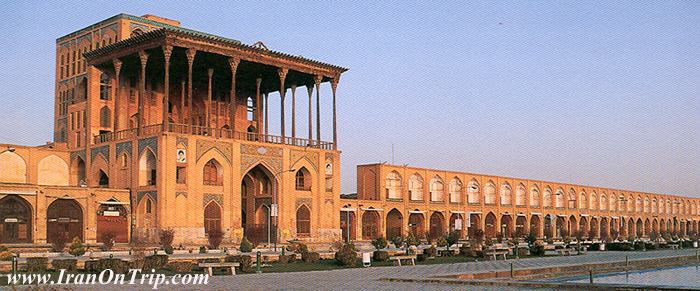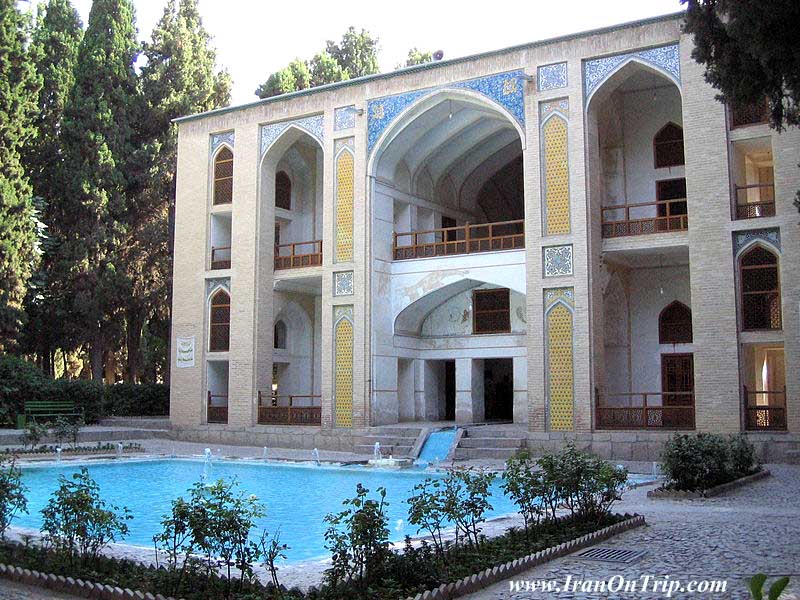Esfahan Historical Palaces and Edifices, Iran
Ali Qapoo Edifice, Esfahan-Iran

This palace was also called 'Daulat Khaneh-e-Mobarakeh Nagsh-e-Jahan' and the 'Daulat Khaneh Palace'. Its unique archaic architecture is related to the Safavid era. This edifice was constructed under the orders of Shah Abbas I. The monarch would receive special envoys in this palace and hold his audience here. Valuable miniature paintings, the works of the reputed artist of the times Reza Abbassi, and other traditional works of art can be noted here.Plasterwork of the 'sound room' was modeled such that the acoustic affect produced natural and pleasant sounds. The sovereign and his guests would be spectators to polo, illuminations, fire-works and the dramatics that took place in the Nagsh-e-Jahan Square from the halls of this elegant palace.Read more
Chehel Sotune Palace, Esfahan-Iran

The Chehel Sotune Palace and its garden cover an area of approximately 67,000 sq. m. This palace was constructed during the reign of Shah Abbas I. Shah Abbas II was also responsible for additions to this palace, such as the hall of mirrors, the hall of 18 pillars and two large chambers facing the north and south. The spectacular hall of mirrors with its decorative mirror work, tile work and paintings, along with its majestic porches and pool which faces this hall, all add to its splendor.The stone lions at the four corners of the central pool, the hall and marble and vaulted cornices around it.The gilded adornments, paintings and the portrait of the sovereign in the royal hall. Along with that of the chambers surrounding the hall of mirrors.The portrait of Shah Abbas I with the special crown and the miniatures of the treasury room.Several facades such as the 'Qotbiyeh Mosque', 'Zaviyeh in Kushk', and the imprints of the 'Dar-e-Joubareh' and 'Aqasi Mosque' are affixed in the western and southern walls of the garden. The hall and porches of this palace were constructed during the fifth year of the reign of Shah Abbas II. The reflection of the twenty pillars of the hall in the pool opposite the palace brings about a conception of forty pillars. Hence the name Chehel Sotune.Read more
Hasht Behesht Palace, Esfahan-Iran
1.jpg)
The Hasht Behesht palace was built in the centre of Baghe Bolbol (The Nightingale Garden) dates back to 1660. The palace is the most important building which was built during Shah Suleiman Safavid time. The palace experienced new styles of stucco work and stained glass and mirror works.Hasht Behesht was renovated by Fathali Shah Qajar in the 19th century. It was used as residential palace by Zele Sultan (Fathali Shah’s son). This useless man even did not maintain ornamentations of the palace.Chahar Taghi is a type of Sassanid and pre – Islamic architecture, but the style was beautifully developed and enlarged at the time of Safavid dynasty. The structure has octagonal shape and this kind of shape can be seen in various part of it. It is two storey palaces which have been seriously damaged.Read more
Ashraf Pavillion, Esfahan-Iran

This hall is located in the inner area of governor office in Ostandari St. which is now used as the Protocol Office. The name Ashraf means majestic and glorious and does not have any attribution with Ashraf-e Afghan. According to the travelogue of Chardin the French traveler, the date of its construction goes back to the time of Shah Abbas II and his successor’s coronation “Shah Soleyman” which was held in this place. It has a flat roof but an arched inner ceiling, ornamented with very exquisite gilt pendentives, and fine stuccos as the most beautiful monument of Safavids.
This Palace which dates from the time of Shah Abbas II is situated just to the west of the main Palace of Ali Qapu and east of another palace, known as Hasht Behesht. It is currently used as an officers' club by the army and is therefore closed to visitors. It derives its name from the period when Isfahan was ruled by Afghanis whose leader, Ashraf, made this building his headquarters.
Beside it is the Natural History Museum which is housed in another fine palace whose somewhat unpreposessing exterior belies the elaborate decoration inside. This is open to the public and is architecturally very similar.
This structure is within the palace and was erected during the reign of Shah Abbas II with the aid of scaffolds. The roof of which is flat and supported by thick, tall columns covered with gold. The said structure was put under repair about fifty years ago, in order to prevent it from being destroyed.
View Talar e Ashraf 
Fin Historical Edifice and Garden,Kashan-Esfahan-Iran

This garden is located to the south of the city of Kashan and near the village of Fin. The same was constructed on the former structures of the Al-e-Booyeh era. Its general layout and aqua system has been rendered special attention. This vicinity gained fame due to the murder of Amir Kabir, the reputed nationalist and Prime Minister (Grand Chancellor) of Nasereddin Shah Qajar. Amir Kabir was assassinated in a small bath here in the year 1268 AH. by the order of the Shah. This garden is a relic from the Safavid period, and has remained such for centuries due to the capacity of water it gains from the Soleimaniyeh spring. Today, this water flows into the 'Lasegah' pool after meandering through this beautiful garden, and providing water for the surrounding areas.The structures of this garden are the entrance and its facade, tower and ramparts, the Safavid and Fathali Shah sections, chambers for the elite, the museum on the western side of the premises, the large and small bath and the library in the eastern sector of this garden.
The covered construction housing the Shah Abbasi section is in two floors, this being in the center of the garden and opposite the grand facade. The construction of the same was completed in the year 1226 AH. Here, there are beautiful paintings and an inscription worked with plaster in the 'nastaliq' script. In the vicinity of this garden, several monarchs such as Shah Safi, Shah Soleiman, Shah Tahmasb, Shah Abbas, Karim Khan Zand and Fath Ali Shah have all contributed in the repair or making addition to the structures on the premises. However, these structures witnessed plunder in the early period of the constitutional revolution.
.....
.....
.....

.jpg)



























